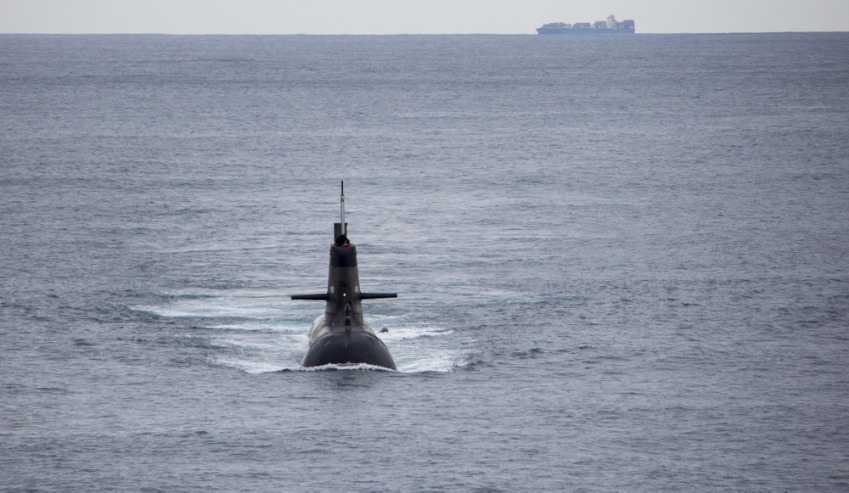Former Royal Australian Navy officer Chris Skinner examines Australia’s new nuclear submarine program, comparing the program’s projected timelines to the life-of-type-extension of the Collins Class and how the Commonwealth can onboard the capabilities gained from SEA 1000 to expedite the new AUSSN.
To continue reading the rest of this article, please log in.
Create free account to get unlimited news articles and more!
The euphoria and surprised reactions to the simultaneous announcement by the leaders of the US, UK and Australia that Australia would benefit from the US and UK nuclear submarine experience and intellectual property has reverberated around the world. This was the feature of the newly formed tripartite alliance pact termed AUKUS bringing together Australia with our longest- standing allies and friends that shared beliefs in common values, democratic processes, and international freedoms and rules-based order. Other benefits of the three-way pact include sharing of technology and research collaboration in cutting-edge technologies including quantum computing, artificial intelligence and cyber warfare defences.
The submarine strategy is visionary but understandably lacks detail that will be developed over an 18-month period with the high-level aim to commit to a program by the end of this decade with the first of eight Australian nuclear attack submarines (abbreviated to AUSSN) by 2040. But that is too late to maintain the Australian submarine force of at least the current six boats, even with the essential Collins Class life-of-type-extension (LOTE) that has recently been confirmed.
Collins LOTE is due to start in 2026 and complete by 2035, so the first LOTE boat will decommissioned in 2038 and they will be all gone by 2045.
The AUSSN acquisition strategy is also unclear, with the UK Astute Class a strong contender as it is smaller than the US Virginia Class and with a smaller crew, an issue for Australia in recruitment, training and retention when there is no nuclear power industry to provide employment for departing nuclear submarine crew members as there is in the UK, US and France.
Then there is the long-standing Australian-US collaboration on the submarine's combat system and common weapons, especially the Mk 48 Mod7 torpedo and submarine-launched anti-ship cruise missile Sub-Harpoon. The task of combat system integration, contracted to Lockheed Martin Australia for the Attack Class, will still be needed if we go with Astute, as the UK submarine combat system differs and so do the primary weapons carried.
So we have a critical uncertainty on timescale and further doubts about complexity of the design baseline for the AUSSN. This has all the hallmarks of similar throw-away statements from high-level decision-makers in the past. The ease with which highly complex engineering design and systems integration is described by marketing and political spokespersons is almost never realised in practice. If it were as easy as they say, then it would be undertaken more often by less experienced groups worldwide.
The complexity of a submarine is sometimes compared with the space shuttle, but that is misleading as the space shuttle is in constant replicated communications with external command and control networks that can support and even override the command crew onboard. Submarines, once dived, are not in two-way communication whatsoever, and this state may persist for days at a time. The reliance on onboard redundancy and expertise, including artificial intelligence, is ever-present, and the design, including systems integration, must reflect this.
Consequently, there is a good argument to put the more than $2 billion already spent on the Attack program to good use by firstly continuing the program based on a reduced number of hulls. Secondly, by further defining the combat system such that it can be employed for the AUSSN design baseline when that is defined in two years’ time. And finally by reviewing all the subcontracts let by Naval Group for the Attack Class for their applicability to transfer to AUSSN.
This will have the triple benefit of getting better value for money from what has been spent on SEA 1000 so far, reducing the risk of a reduction of boat numbers in the Australian submarine force before the AUSSN starts to deliver, and thirdly to give some recognition of the effort invested by Naval Group and their support from the government of France.
Christopher Skinner served 30 years in the Australian Navy as a weapons and electrical engineer officer in six surface warships, including deployments to South-East Asian Treaty Organisation, the Vietnam War and surveillance of the North-West Indian Ocean. He served overseas on training and ship modernisation programs and was seconded to the United States Naval Sea Systems Command in Washington DC to manage the test and evaluation of the lead ship of a joint Australian-US frigate program. He is a member of several organisations and institutes engaged in geopolitics, technology and submarine matters, and is a councilor of the Australian Institute of International Affairs, NSW division. The views expressed above are entirely those of the author and are not endorsed by any of the organisations of which he is a member.

 Login
Login







